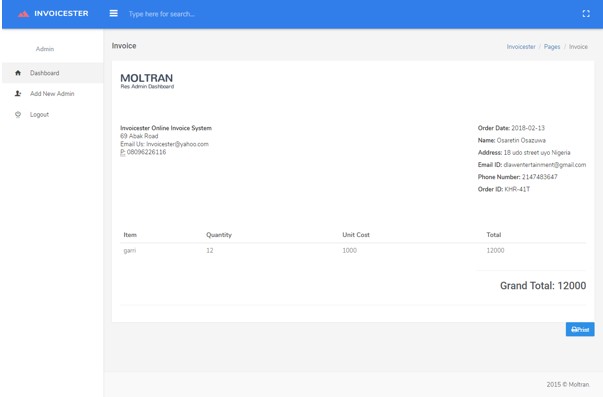Design and Implementation of an Electronic Invoicing System

Design and Implementation of an Electronic Invoicing System
Chapter One of Design and Implementation of an Electronic Invoicing System
INTRODUCTION
The internet, without doubt, has played an important role in digitalizing business processes across companies and organizations of all sizes. It has introduced multiple new channels through which businesses can interact with their customers [1]. A report by Gartner, an Information Technology (IT) research institution, reveals that 70% of all customer interactions will move towards digital, more interactive settings and would be experienced on demand through mediums such as web, mobile and social media platforms by 2017. The generation of today understands technology more than ever and require services delivered as quickly as possible, whenever and wherever they desire [2].
To achieve all these, companies do not have to make huge capital investments by purchasing and maintaining software licenses for applications like Enterprise Resource Planning (ERP), Inventory Management System (IMS) and Customer Relationship Management (CRM) systems and installing them on individual hardware on the business premises [3]. They can instead contain costs, deploy solutions quicker and minimize risk by using this Electronic Invoicing System hosted by a third party and delivered over the internet , Its purpose is to bring an inexpensive and easy solution to the business operation needs of customers especially the Small and Medium-sized Enterprises (SMEs). The system allows businesses to create and send computerized invoices to their customers [4].
STATEMENT OF PROBLEM
During the analysis and data collection of this project, it was discovered that there existed a manual form of collecting and storing customers’ invoices in other for them to be attended to, and for future purpose [5].
That is to say that the process of daily task and activities are done manually which is quite unfortunate; manual procedural execution produced delays in writing down all the customer bought, at some instances the business owner can’t keep a proper record of the goods and services sold out in a particular day, week or Month, which reduces result in businesses.
Manual invoicing record keeping has resulted in many setbacks to the expected standard. The setback encountered includes:
- Time wastage in writing down everything bought by some customers.
- Partial or total loss of invoice by both business and customers.
- Under recording of invoice analysis.
- Inefficiency of some members of staff due to laziness in searching of the invoice.
As a result of these problems, the manual system of invoice record information storage, input and retrieval is very clumsy: inefficient and unbelievable.
PURPOSE OF THE STUDY
To develop a computerized Electronic Invoicing software to carryout tedious work and activities performed by human beings, in which they end up misplacing and discarding some important files and costumers records. But if this (computerized Invoicing software) is implemented and installed it will render remedy to this case.
AIMS AND OBJECTIVES
The main aims and objectives of the system are:
- To design a web based invoicing system to replace some extent of human role in cases of unavailability of job.
- To provide quick retrieval of customer’s invoice records on site or case of loss of original invoice.
Also, the purpose of this software is to model a computerized invoice system to enable proper invoice generating for customers and control this records.
SCREEN SHOTS OF THE APPLICATION



SCOPE
The researcher is concerned with an electronic invoice system. It cover all the operations of companies and businesses in issuing receipts to customers which is the case study. It deals with the digitalizing business processes of issuing of receipts to customers for the services rendered or bought.
ORGANIZATION OF STUDY
Chapter Two reviews the related literature under the following sub-headings: Invoicing System, the review of the site, electronic invoicing system, Implementation of the new mode of receipts, etc.
Chapter Three handles the System Methodology Analysis and Design as follows: Introduction, the User Interface, Hardware and Software requirements, user documentation, system backup, system maintenance, etc.
Chapter four is concerned with the system implementation and programming.
Chapter Five comprises of summary, conclusion and recommendation.
LIMITATION OF THE STUDY
There are some limitations or constraints confronting this study, they are as follows
- TIME: I have a very little time to carry out this research this was the fact that I combine the research work with my academic studies. You can agree with me that time constraints is one of the limitations I experience while carry out this research work.
- FINANCE: however, finance is another constraint I experience while carry out this research. The lack of funds to carry out this research slow down the research work. Despite the limitations every effort was geared towards accomplishing this project.
DEFINITION OF TERMS
Transaction:
Agreement, contract, exchange, understanding or transfer of cash or property that occurs between two or more parties.
Database:
A collection of different files in a specialized way for easy retrieval and update.
Invoice:
A nonnegotiable commercial instrument issued by a seller to a buyer. It identifies both the trading parties and list describes and quantifies the items sold, show the date of the shipment and mode of transport, prices and discounts (if any) and delivery and payment terms.
Inventory:
An itemized catalog or list of tangible goods or property, or the intangible attributes or qualities.
Computerized:
Convert (information) to a form which is stored or processed by computer.
Customer:
A person who buys goods or services from a shop or business.
Electronic:
Controlled by or connected to a computer and as an activity or service which is “available on or performed using the Internet or other computer network”.
Record:
Document that memorializes and provide objectives of activities performed, resulted achieved, or statement made.
